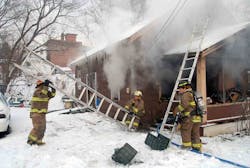Facts About Volunteer Firefighters
Following are some interesting facts an figures about the volunteer firefighters who serve our communities across the United States.
- Of the fire departments registered with the National Fire Service Department Census, 87% of them are all volunteer or have some volunteers.
- Communities served by volunteer firefighters depend on them to be their first line of defense for many types of emergencies -- more than just fight fires.
- 1,140,750 firefighters protected the United States in 2013. 354,600 (31%) were career firefighters and 786,150 (69%) were volunteer firefighters. (NFPA)
- Most volunteer firefighters (95%) are in departments that protect fewer than 25,000 and more than half are located in small, rural departments that protect fewer than 2,500 people. (NFPA)
- Two-thirds of fire department responses were medical aid calls in 2013.(NFPA)
- Only 4% of fire department calls in 2013 were due to actual fires. (NFPA)
- The time donated by volunteer firefighters saves localities across the country an estimated $139.8 billion per year. (NVFC)
- The number of volunteer firefighters in the United States has declined by about 12% since 1984. From nearly 900,000 in 1984 to 786,000 in 2013. (NVFC)
- Major factors contributing to the decline include increased time demands, more rigorous training requirements, and the proliferation of two-income families whose members do not have time to volunteer. The two greatest sources of increased time demands are increased volume of emergency calls and increased training hours to comply with training standards.
- While the number of volunteer firefighters is declining, the age of volunteer firefighters is increasing. (NVFC)
- While the number of volunteer firefighters is declining, the age of volunteer firefighters is increasing. (NVFC)
- Departments are finding it difficult to attract younger members due to a range of reasons, including increased demands on people’s time, longer commuting distances to and from work, the prevalence of two-income households, and increased training requirements.
- Fire department call volumes continue to increase.
- Most fire departments across the country have experienced a steady increase in calls over the past two decades. This is a major source of the increased time demands on volunteer firefighters. The increase in calls, coupled with the decline in the number of volunteer firefighters, means that fire departments have to do more with less. Most of the increase is attributed to a sharp increase in the number of emergency medical calls and false alarms. (NVFC)
- Small and mid-sized communities rely heavily on volunteer firefighters.
- Small communities (populations under 10,000) across the U.S. are typically protected by all volunteer departments. Mid-sized communities (populations above 10,000) are typically served by combination volunteer and paid departments. Large communities (populations over 100,000) are most often protected by combination volunteer and paid departments that consist of primarily paid staff. (NVFC)
